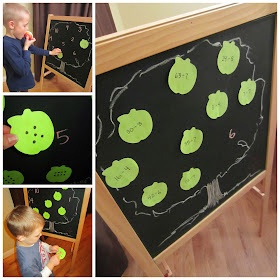Learning letters has been a challenge for my little guy
and while he's getting a fair amount of practice in preschool, it just isn't
sticking.
Since I think it's equally important for kids to
recognize the letters as it is to begin to associate the sounds they make with
them, I decided we'd do a little extra work at home.
My mom, a retired elementary school teacher, supplied the
idea for this genius file folder game. It's geared toward kindergarteners, but
with some assistance can be ideal for PreK application too.
Before we got busy playing our "letters game,"
my son watched a great phonics DVD from Leap Frog. I'd recommend this for kids
ages as young as two and as old as six.
This great file folder game is perfect for reviewing two
letters and their sounds at a time. Kids have to decide which shapes contain
pictures of objects that begin with a particular letter. It's simple and smart
and SO helpful.
Download FREE from Google Drive:
Construction
Option #1: 13 file folders
You'll need 13 file folders, 26 sheets of sticker paper
(or office paper and glue), 26 sheets of heavyweight cardstock, and sticky-backed
velcro. On the A-M file, print the odd numbered pages on cardstock and the even
pages on sticker paper. On the N-Z file, do the same, but do not print page 23
(it's blank and you won't need it).
Now cut the letters and all the shapes from the sticker
paper pages (or if the pages fit on your file folder, simply peel and stick the
entire page, one page per side). Each file folder will have two letters. You
can pick and choose whether you put the letters in alpha order (e.g. your
folder could have A and B or O and T). Some phonics programs mix the letters,
so feel free to do the same.
Now cut out the cardstock shapes and adhere velcro to the
back and to the corresponding shape on the file folder.
Construction
Option #2: 1 file folder
You'll need 1 file folder, 2 sheets of sticker paper (or
office paper and glue), access to lamination, 26 sheets of heavyweight
cardstock, and sticky-backed velco.
Print two copies of page 23 on the N-Z PDF file onto
sticker paper. Either cut everything out, or if it fits, simply peel and stick
to each side of the file folder. Laminate the folder. Now print the odd number
pages on the A-M and N-Z PDF file (with the exception of page 23 which you
already printed) onto cardstock. Cut out. Attach sticky-back velcro: 10 pieces
of the fuzzy side to the shapes on the laminated folder and the hook side of
velcro to each of the cardstock shapes.
Write the letters (upper and lower case) on the folder in
the handwriting box using dry-erase marker.
To Use:
Give the child one folder and the shapes that correspond
to each of the two letters inside. (I put the shapes in an envelope in the
folder, which could be velcroed to the folder for storage.)
Remind the child what the letters are and the sounds they
make. Have them determine where the shapes belong and attach them. For example,
on and A-B folder, the child will have to determine if the apple in the yellow
circle or the baby in the yellow circle
belongs on the A side of the folder; "Does it make the aw sound or the ba
sound?"
My son really surprised me with this. I'm looking forward
to making more of these folders for him.
To keep the letter/phonics work going, we read K is for Kissing a Cool Kangaroo. This
book is a lot of fun for kids who can challenge themselves to find all the
objects pictured that start with the letter noted in the text.

.jpg)




































